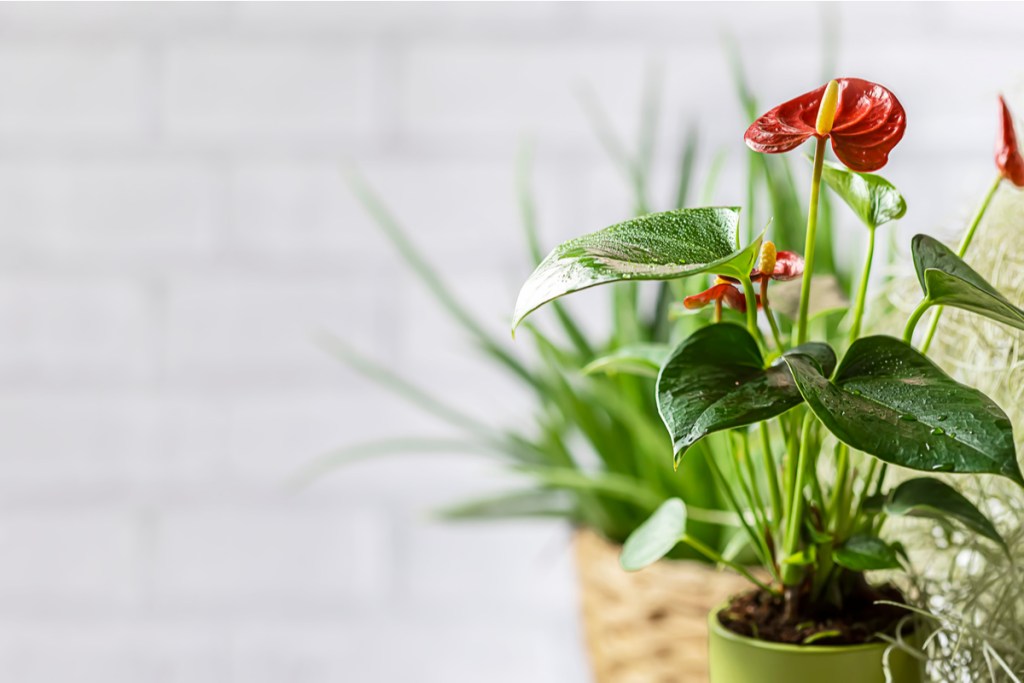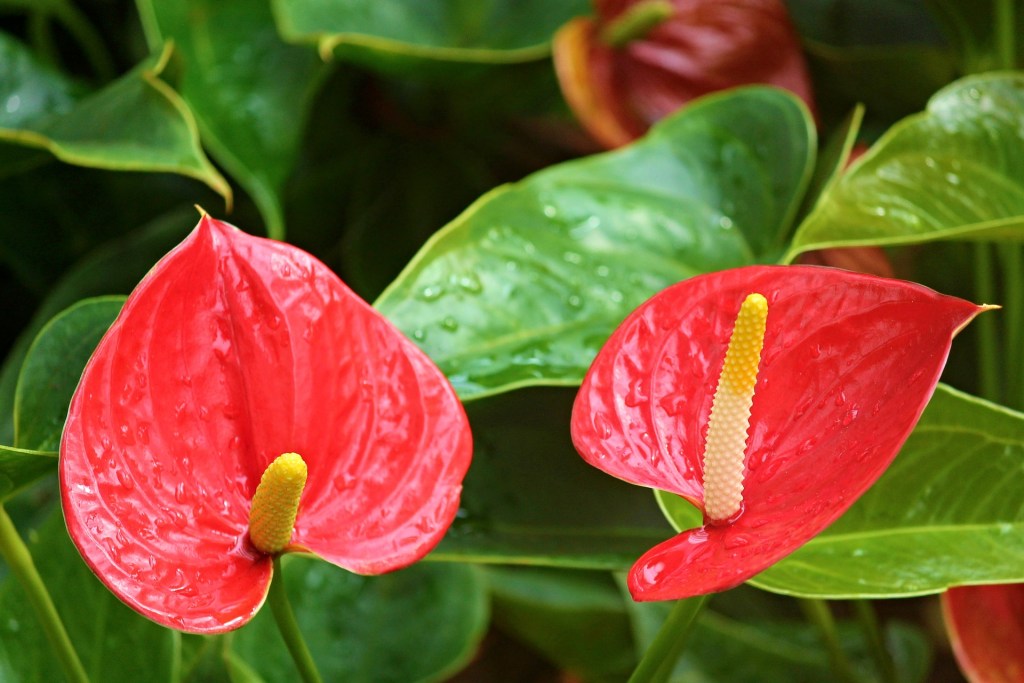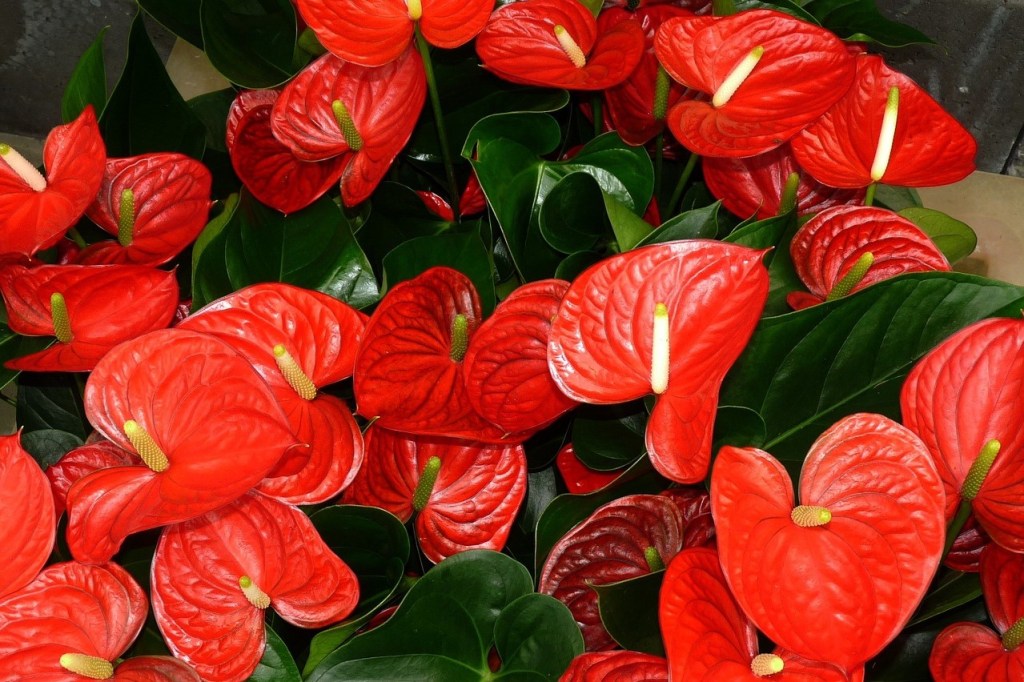Anthuriums are stunning tropical plants with vibrant flowers and glossy leaves, so it's no wonder they're popular as houseplants. Their tropical environment is easier to replicate inside or in a greenhouse, meaning they're more at home indoors than out. If you want to bring this beautiful plant into your home, then you'll need to know all about anthurium care.
Anthurium plants are hardy in zones 10 and higher. Red anthuriums are very common, but you can find white and pink plants and even plants that are shades of yellow, burgundy, and green. Some gardeners grow them to admire their foliage, while others like them for the beautiful colors the anthurium has to offer.
But be aware that this plant — also known as the “flamingo flower” — can be fussy. As most plants do, the anthurium needs certain care conditions to be met in order to really thrive. Although they can be trickier to care for than some plants, it's worth the effort to see these beautiful plants in your home. This guide to indoor anthurium care will answer all your questions, so your anthurium can thrive.

Is it easy to grow anthurium plants indoors?
As with most indoor plants, your anthurium will do best when potted with well-draining soil in a container that has good drainage. Follow these steps for growing your plant indoors:
Step 1: Keep the soil moist when watering, but not wet (as you don’t want your anthurium sitting in soggy soil and potentially rotting).
Step 2: Use a pot that the anthurium can grow into instead of out of, to avoid repotting too much.
Step 3: Repot when you see roots begin to come above the soil.
Step 4: Provide your anthurium with some additional support in the form of a garden stake or skewer if it has trouble supporting itself.
When they grow in their natural environment, anthuriums tend to grow off other plants instead of in soil. This can lead to difficulty staying upright when in soil.

How do you water anthurium plants?
Anthuriums prefer an environment in which the soil is moist, not wet, and never dries out completely. Since they prefer a moist environment, anthuriums will require regular watering. Be wary of overwatering and drowning the plant. Anthuriums are prone to root rot if the soil is wet for too long.
On the other hand, allowing the soil to dry out too much will slow the growth of the plant and make it difficult for the roots to become wet again. Unlike hardy houseplants, the anthurium is one that needs close monitoring to ensure you’re providing it with the care it needs.
Here's how to make sure they get the right amount of water:
Step 1: Use a pot with good drainage.
Step 2: Avoid overwatering your anthurium by paying close attention to when the water begins to seep out the bottom and into the tray.
Step 3: Water again when the top of the soil is dry to the touch.

What type of soil do anthuriums prefer?
Anthuriums need their soil to drain well but be able to hold some water. This is how to choose the best soil for them:
Step 1: Use a well-draining soil and a pot with a drainage hole.
Step 2: Use a potting mix designed for orchids with some additional sand and peat moss.
Step 3: Try a half-and-half mixture of regular houseplant potting soil and orchid mix if you are unable to add sand and peat moss.
This gives you a similar environment to the one with sand and peat moss, and your anthurium will still be happy.

What’s the best light for anthuriums?
Anthuriums can grow in all levels of indirect lighting, so if you live in a dimmer space, you still have a shot at keeping an anthurium as a houseplant. Here's how to choose the best lighting for your anthurium:
Step 1: Keep in mind that anthuriums grown in lower lighting will grow slower and have fewer flowers than those grown in bright, indirect lighting.
Step 2: Don't place your plant in direct lighting. Anthuriums have a low tolerance for direct sunlight, and their leaves will easily burn.
Step 3: Put your anthurium in bright, indirect light for the best growing environment.
Step 4: Use a grow light as a supplement if you don't have the right natural lighting.

What if the anthurium isn’t blooming?
Like we said — anthuriums can be tricky. If the anthurium isn’t blooming, it may be because it isn’t getting the exact mixture of humidity, light, water, and soil that it requires. Here's how to find and correct the problem:
Step 1: Troubleshoot first by making sure you’re following the directions, as listed above.
Step 2: Fertilize the plant occasionally — about once every one to two weeks.
Step 3: Use a phosphorus-rich fertilizer diluted to quarter strength.
Step 4: Keep in mind that anthuriums should be repotted every two to three years. Repot them to help them continue growing and pushing out new blooms.

What to do after your anthurium blooms
All blooms will come to an end, so don't fret if your anthurium flowers (which are really spathes enclosing the actual spadix flowers) start wilting at some point — that's simply a part of its life cycle!
After two to three months, anthurium blooms will start to die down. As with many other types of flowers, you'll want to do a bit of cleaning up when this happens. The good news is, anthuriums can bloom all year long with proper care, even after their initial flowers fade. Here's what to do after an anthurium flower wilts:
Step 1: Identify brown, wilting flowers and plan to cut them to help your plant redirect its energy toward new growth.
Step 2: With sterilized pruning shears, go all the way down to the base and cut down the stalk with the wilted flower. Using a clean cutting tool helps you prevent spreading any unwanted diseases.
Step 3: While you have your clean shears ready, prune any wilted or dying leaves. You can also prune your anthurium to shape it, but keep at least three leaves.
Step 4: For future blooms, ensure you're following the tips listed in the sections above to give your plant the ideal humidity, watering, light, soil, and fertilizer for flowering. With proper care, anthuriums can bloom up to six times a year.

Can I propagate anthuriums?
Yes! And doing so when you repot is the perfect time. Here's what to do:
Step 1: Take a stem cutting that has at least two nodes.
Step 2: Root it in water or perlite, or push it directly in the soil.
The cutting may take some time to grow, but so long as you’re patient, you’ll be sure to see results.

What to do about brown anthurium leaves
One of the most common problems people notice with anthuriums is leaves turning brown. This can be alarming and confusing if you aren't sure what's causing it or what you should do about it. Don't panic! There are a few simple reasons your anthurium's leaves might be turning brown, and they're easy to fix. Sunburns caused by exposure to direct sunlight, an environment that is too hot or cold, and your plant receiving too much or too little water are the main causes of anthurium leaves turning brown.
Identifying the cause and adjusting your anthurium's environment accordingly will stop more leaves from turning brown. However, the leaves that are already brown may not recover. Instead, clip them off the plant with scissors or shears. This allows your anthurium to redirect it's energy to growing new, healthy leaves.
Remember that anthuriums are still tropical plants. Proper anthurium care means they need to grow in humid, moist environments. Recreating these conditions as best you can will give your anthurium the best shot at thriving. When it’s colder/drier out, you’ll want to mist your plant to increase humidity levels or even run a humidifier.



